- Details
- Written by: Elmazen
- Category: Flags of Countries of the World
- Hits: 737
Flag of El Salvador, Currency, Population, Tourist Places
El Salvador: A Glimpse into the Heart of Central America
El Salvador, located in Central America, is known for its rich culture, beautiful landscapes, and vibrant history.
Here’s an overview of the country, including information about its population, national symbols, borders, culture, currency, and top attractions.
Flag of El Salvador, Currency, Population, Tourist Places
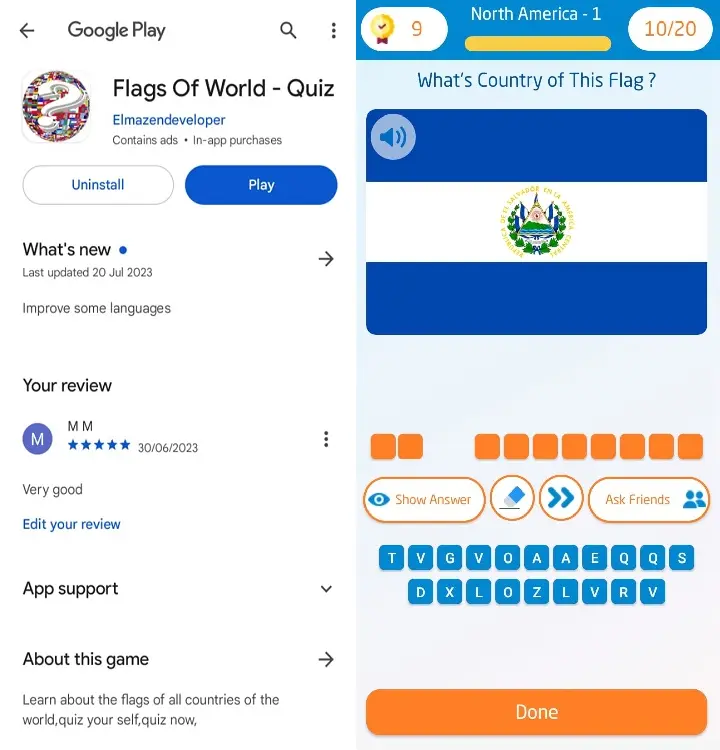
Download the application  Flags Of World - Quiz ,
Flags Of World - Quiz ,
And test your knowledge with Flags of World ,
1. Population of El Salvador:
As of November 2024, El Salvador has a population of around 6.34 million people.
Despite being the smallest country in Central America, El Salvador is densely populated and is a vibrant mix of indigenous heritage and Spanish influence, with a majority of the population living in urban areas.
2. Meaning of El Salvador’s National Flag:
El Salvador's flag is composed of three horizontal stripes: blue, white, and blue.
The blue bands represent the Pacific Ocean and the Caribbean Sea, which border Central America.
The white stripe symbolizes peace and unity.
In the center of the flag, the national coat of arms features a triangle with five volcanoes, symbolizing the five nations that were once part of the United Provinces of Central America.
Above the volcanoes, a red Phrygian cap represents liberty, and a rainbow stands for peace.
3. El Salvador’s Currency:
The official currency of El Salvador is the United States dollar (USD), which has been in use since 2001 when it replaced the Salvadoran colón.
More recently, El Salvador made headlines by becoming the first country to adopt Bitcoin as legal tender in 2021, allowing citizens and businesses to use both USD and Bitcoin in daily transactions.
Flag of El Salvador, Currency, Population, Tourist Places

Download the application  Flags Of World - Quiz ,
Flags Of World - Quiz ,
And test your knowledge with Flags of World ,
4. Borders of El Salvador:
El Salvador shares borders with two countries: Honduras to the northeast and Guatemala to the northwest.
To the south, it has a long coastline along the Pacific Ocean, making it the only Central American country without a Caribbean coast.
The country’s geographic location provides it with a diverse landscape, including mountains, volcanoes, and beautiful beaches.
5. Culture of El Salvador:
El Salvador has a rich cultural heritage influenced by its indigenous roots and Spanish history.
The majority of Salvadorans are mestizo, meaning they have a mix of indigenous and European ancestry.
Traditional music and dance, such as the *Xuc* (a traditional Salvadoran rhythm), play a central role in Salvadoran festivities.
El Salvador is also known for its colorful arts and crafts, including ceramics and textiles.
Cuisine in El Salvador is distinctive and well-loved across Central America, with *pupusas* (thick corn tortillas stuffed with cheese, beans, or meat) standing as the national dish.
Salvadoran culture is closely tied to religious celebrations, with a predominantly Roman Catholic population, though Protestantism has also gained a significant following.
6. Best Places to Visit in El Salvador:
El Salvador offers a range of stunning natural and cultural sites for visitors.
Here are some must-see places:
San Salvador : The capital city has historical sites, vibrant markets, and the impressive National Palace.
The Metropolitan Cathedral, which houses the tomb of Archbishop Óscar Romero, is also located here.
Suchitoto : This charming town is known for its cobbled streets, cultural festivals, and nearby Lake Suchitlán, offering beautiful scenery and opportunities for water activities.
El Boquerón National Park : Located near San Salvador, this park features the Boquerón volcano, with a striking crater offering spectacular hiking and viewpoints.
Ruta de las Flores (The Flower Route) : A popular route in the mountainous western part of the country, the Ruta de las Flores takes visitors through scenic villages known for coffee plantations, waterfalls, and weekend artisan markets.
El Tunco Beach : Famous among surfers, El Tunco Beach offers breathtaking sunsets, a laid-back vibe, and excellent waves.
It's also a great spot for exploring nearby caves and tide pools.
Joya de Cerén : Often called the “Pompeii of the Americas,” this UNESCO World Heritage site is a preserved Mayan village buried by volcanic ash, providing a fascinating glimpse into ancient indigenous life.
El Salvador may be small in size, but it’s a country packed with cultural richness, scenic beauty, and a warm and welcoming population.
From its flag and currency to its best travel destinations, El Salvador stands as a unique gem in Central America.
Flag of El Salvador, Currency, Population, Tourist Places

Download the application  Flags Of World - Quiz ,
Flags Of World - Quiz ,
And test your knowledge with Flags of World ,
- Details
- Written by: Elmazen
- Category: Flags of Countries of the World
- Hits: 677
Flag of the Dominican Republic
The Dominican Republic, located in the Caribbean, is known for its vibrant culture, beautiful landscapes, and rich history.
Here’s an overview of what makes this country unique, addressing your points of interest.
Flag of the Dominican Republic
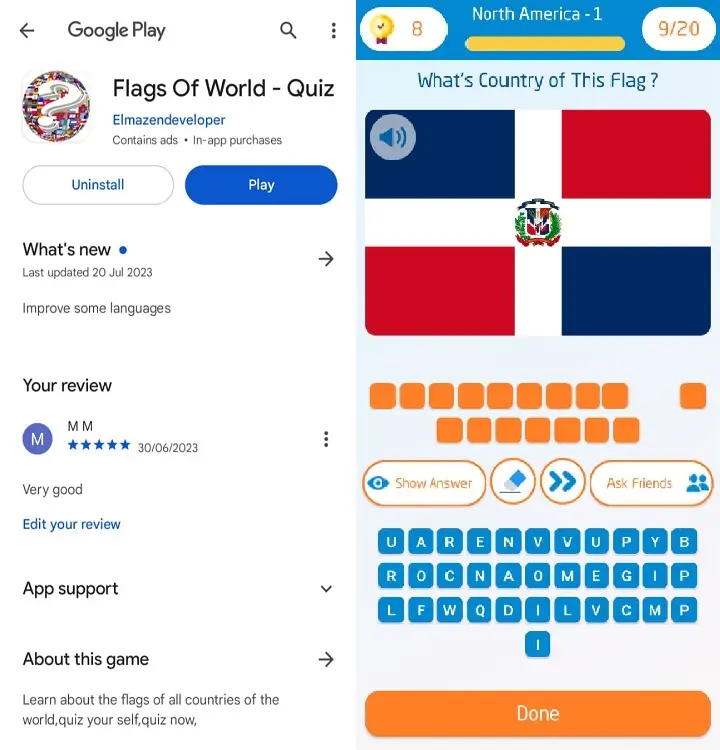
Download the application  Flags Of World - Quiz ,
Flags Of World - Quiz ,
And test your knowledge with Flags of World ,
1. Population of the Dominican Republic :
As of November 2024, the population of the Dominican Republic is around 11.45 million people.
This diverse population includes a mix of cultures and ethnic backgrounds, largely due to the country's historical influences from indigenous Taíno people, African heritage, and European, primarily by the Spanish.
2. Meaning of the Dominican Republic’s Flag :
The Dominican Republic’s flag is rich in symbolism and is unique among world flags for prominently featuring a Bible.
The flag has a central white cross, symbolizing faith and salvation, which divides it into four quadrants.
The two blue quadrants represent liberty, while the red signifies the blood of those who fought for the country’s independence.
In the center, there’s a coat of arms with a shield, Bible, and cross, accompanied by the motto *“Dios, Patria, Libertad”* (God, Fatherland, Liberty).
3. Currency of the Dominican Republic :
The currency of the Dominican Republic is the Dominican peso (DOP).
The peso is abbreviated as “RD$” when used domestically.
It’s available in both coins and banknotes, with banknotes bearing images of important historical figures, national landmarks, and symbols.
Flag of the Dominican Republic

Download the application  Flags Of World - Quiz ,
Flags Of World - Quiz ,
And test your knowledge with Flags of World ,
4. Borders of the Dominican Republic :
The Dominican Republic shares the island of Hispaniola with Haiti, making it one of the few countries in the world that shares an island with another nation.
To the east is the Atlantic Ocean, while the Caribbean Sea lies to the south. Despite the shared island, the Dominican Republic and Haiti have distinct cultural identities and political boundaries.
5. Culture of the Dominican Republic :
Dominican culture is a lively blend of Taíno, African, and Spanish influences.
Music and dance are central to Dominican life, with *merengue* and *bachata* being the most popular styles.
Dominicans are also known for their passion for baseball, with the country producing many famous Major League Baseball players.
The cuisine of the Dominican Republic is another reflection of its cultural heritage, featuring dishes like *mangu* (mashed plantains), *sancocho* (a hearty meat stew), and *arroz con habichuelas* (rice with beans).
Family and community are highly valued, and Dominican festivals, especially during Carnival season, are marked by colorful costumes, music, and dancing.
6. Best Places to Visit in the Dominican Republic :
The Dominican Republic is known for its breathtaking natural landscapes and vibrant cities.
Here are some must-visit spots:
Punta Cana : Famed for its white-sand beaches and luxurious resorts, it’s a paradise for beach lovers and offers activities like snorkeling and golfing.
Santo Domingo : The capital city is the oldest continuously inhabited European settlement in the Americas.
The Colonial Zone is a UNESCO World Heritage Site, filled with historic buildings, cobbled streets, and vibrant nightlife.
Puerto Plata : Known for its golden beaches and lush mountains, it also has cultural attractions like the Amber Museum and the 16th-century San Felipe Fortress.
Samaná Peninsula : This area is ideal for eco-tourists, with stunning beaches, lush forests, and the opportunity to see humpback whales during the migration season.
Jarabacoa and Constanza : Located in the Dominican Alps, these areas are perfect for adventure tourism, offering hiking, river rafting, and breathtaking views.
Lake Enriquillo : The largest lake and the lowest point in the Caribbean, it’s a unique natural site home to American crocodiles and flamingos.
The Dominican Republic is a destination that offers both natural beauty and a warm, welcoming culture, making it a memorable place for travelers.
Flag of the Dominican Republic

Download the application  Flags Of World - Quiz ,
Flags Of World - Quiz ,
And test your knowledge with Flags of World ,
- Details
- Written by: Elmazen
- Category: Flags of Countries of the World
- Hits: 688
Flag of Dominica, Population, Borders
Exploring Dominica: The Nature Island of the Caribbean
Dominica, often called the "Nature Island," is one of the most lush and ecologically diverse islands in the Caribbean.
Known for its untouched rainforests, stunning waterfalls, and vibrant culture, Dominica is an attractive destination for eco-tourists and adventurers.
Let's dive into some key aspects of this beautiful island nation.
Flag of Dominica, Population, Borders
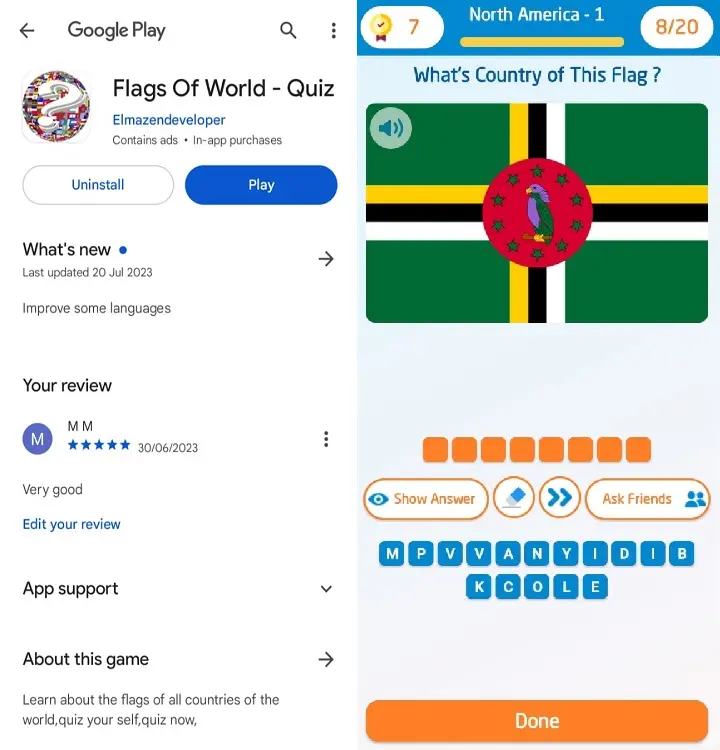
Download the application  Flags Of World - Quiz ,
Flags Of World - Quiz ,
And test your knowledge with Flags of World ,
1. Population of Dominica:
As of November 2024, Dominica has a population of around **66,000 people**.
It is one of the least populated Caribbean nations, contributing to its reputation as a peaceful and tranquil escape.
The population is largely concentrated in the capital city, **Roseau**, and other small towns across the island.
Dominicans are known for their warmth and hospitality, and the population is a mix of African, indigenous Kalinago, European, and East Indian descent.
2. Meaning of Dominica's Flag:
The flag of Dominica is a striking symbol with rich colors and unique elements:
Green Background : Represents the lush vegetation and natural beauty of the island.
Yellow, Black, and White Cross : The three bands symbolize the Christian Trinity and represent the island’s culture, ethnicity, and natural resources.
Yellow stands for sunshine and the fertile soil, black represents the African heritage of many Dominicans, and white symbolizes the clarity of Dominica’s rivers.
Red Circle with Sisserou Parrot : In the center, a red circle holds the Sisserou Parrot, an endangered bird unique to Dominica and a national symbol.
The parrot is surrounded by ten green stars, representing the island’s ten administrative parishes.
The flag highlights the importance of nature, diversity, and cultural heritage to Dominicans.
3. Currency of Dominica:
The official currency of Dominica is the **Eastern Caribbean Dollar (XCD)**, commonly represented by the symbol "$" or sometimes as "EC$" to differentiate it from other dollar currencies.
The Eastern Caribbean Dollar is also used by other Eastern Caribbean nations, and its value is pegged to the U.S. dollar, offering stability for both locals and tourists.
Flag of Dominica, Population, Borders

Download the application  Flags Of World - Quiz ,
Flags Of World - Quiz ,
And test your knowledge with Flags of World ,
4. Dominica’s Borders:
Dominica is an **island country** in the Caribbean, situated between the French territories of **Guadeloupe** to the north and **Martinique** to the south.
Because it is an island, Dominica has no land borders with other countries.
Its location in the Eastern Caribbean places it between the Caribbean Sea and the Atlantic Ocean, giving it stunning coastlines, crystal-clear waters, and diverse marine life.
5. Culture of Dominica:
Dominica’s culture is a unique blend of **African, European, and Indigenous Kalinago influences**.
The island’s rich cultural tapestry is reflected in its music, dance, festivals, and cuisine.
Language : The official language is English, but Dominican Creole, which is heavily influenced by French, is widely spoken.
Music and Dance : Dominica is famous for its vibrant music scene, including **cadence-lypso, zouk, reggae, and calypso**.
The annual World Creole Music Festival is a major event, celebrating Creole music and attracting international audiences.
Cuisine : Dominican food is a delightful mix of Creole flavors, with dishes like callaloo soup, mountain chicken (a local delicacy made from a type of frog), and pelau, a one-pot rice dish.
Festivals : Dominica celebrates its Independence Day with traditional music, dance, and the vibrant Creole Day, where locals dress in traditional attire and celebrate Creole heritage.
6. Best Places to Visit in Dominica:
Dominica’s landscapes and attractions make it a paradise for nature lovers.
Some must-visit places include:
Morne Trois Pitons National Park : A UNESCO World Heritage site, this park boasts lush rainforests, waterfalls, and volcanic landscapes.
Highlights include the **Boiling Lake**, one of the world’s largest hot springs, and the **Emerald Pool**, a tranquil waterfall and pool surrounded by greenery.
Trafalgar Falls : Known as “Mother and Father,” these twin waterfalls are a popular spot for hiking and swimming.
Champagne Reef : Named for the bubbles caused by underwater volcanic activity, Champagne Reef is a favorite for snorkeling and diving, allowing visitors to explore coral reefs and tropical fish.
Kalinago Territory : Home to the indigenous Kalinago people, this area offers insight into the island’s indigenous heritage and traditional ways of life.
Scotts Head : This scenic peninsula provides a panoramic view of the Caribbean Sea meeting the Atlantic Ocean and offers excellent snorkeling spots.
Roseau : The capital city, Roseau, combines colonial charm with a bustling market atmosphere.
It’s a great place to explore local art, cuisine, and architecture.
Conclusion:
Dominica’s unique natural beauty, vibrant culture, and warm people make it a standout in the Caribbean.
Whether exploring its lush rainforests, diving into its underwater wonders, or immersing in its Creole heritage, visitors to Dominica will find an island that lives up to its title as the "Nature Island ".
Flag of Dominica, Population, Borders

Download the application  Flags Of World - Quiz ,
Flags Of World - Quiz ,
And test your knowledge with Flags of World ,
- Details
- Written by: Elmazen
- Category: Flags of Countries of the World
- Hits: 706
Flag of Cuba, Currency, Population
Cuba: A Guide to its Population, Flag, Currency, Borders, Culture, and Best Places to Visit
Cuba, the largest island in the Caribbean, is known for its vibrant culture, rich history, and stunning landscapes.
Here’s a closer look at Cuba, covering everything from its population and flag symbolism to must-visit locations.
Flag of Cuba, Currency, Population
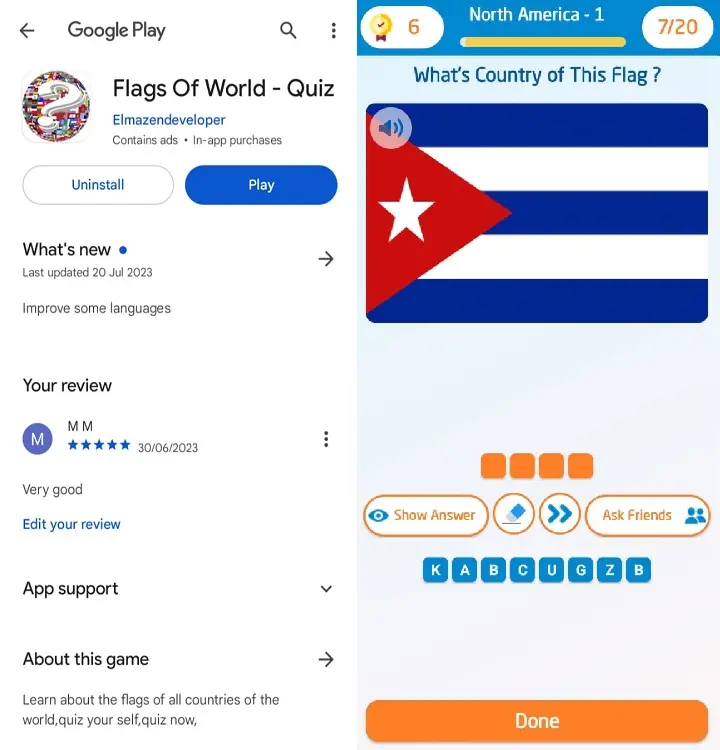
Download the application  Flags Of World - Quiz ,
Flags Of World - Quiz ,
And test your knowledge with Flags of World ,
1. **Population of Cuba**
Current Population : As of November 2024, Cuba has approximately 10.9 million residents, making it the most populous island in the Caribbean.
The population is diverse, with African, Spanish, and indigenous influences due to its history.
Demographics : The population is largely urban, with about 75% of Cubans living in cities.
The capital city, Havana, is the largest city, with over 2 million residents.
2. **Meaning of the Cuban Flag**
Design and Colors : The Cuban flag consists of five horizontal stripes (three blue and two white) and a red equilateral triangle on the hoist side, containing a white star in the center.
Symbolism :
Blue Stripes : These represent Cuba's original three divisions or provinces.
White Stripes : Symbolize the purity and strength of the Cuban cause.
Red Triangle : Represents the blood shed in the struggle for independence and freedom.
White Star : Known as the "lone star," it stands for independence and unity.
3. **Currency of Cuba**
Currency : Cuba’s official currency is the Cuban Peso (CUP), which is mainly used by locals.
However, the Cuban Convertible Peso (CUC) was also used until it was phased out in recent years.
Today, tourists often use the CUP, although some places may also accept major foreign currencies.
Currency Abbreviation : CUP stands for Cuban Peso.
Flag of Cuba, Currency, Population

Download the application  Flags Of World - Quiz ,
Flags Of World - Quiz ,
And test your knowledge with Flags of World ,
4. **Cuba's Borders**
Geographical Location : Cuba is an island nation located in the Caribbean Sea.
It does not share land borders with any other countries but is geographically close to several.
Nearest Neighbors :
North : The United States, specifically Key West, Florida, is around 90 miles north across the Florida Straits.
West : Mexico’s Yucatán Peninsula lies to the northwest.
South : Jamaica and the Cayman Islands are south of Cuba.
East : Haiti and the Dominican Republic are located across the Windward Passage.
5. **Culture of Cuba**
Music and Dance : Cuban culture is world-renowned for its music, especially genres like son, salsa, mambo, and rumba.
Cuban jazz is also internationally acclaimed.
Music and dance are integral to Cuban life, and you’ll often find live music performances in public squares and cafes.
Literature and Art : Cuba has a strong literary and artistic heritage, influenced by both European and African traditions.
Cuban literature often reflects themes of revolution, identity, and resilience, with notable writers like José Martí and Nicolás Guillén.
Cuisine : Cuban cuisine combines Spanish, African, and Caribbean flavors.
Common dishes include *ropa vieja* (shredded beef), *moros y cristianos* (black beans and rice), and *tostones* (fried plantains).
Street food like *empanadas* and *croquetas* are also popular.
Festivals : Cuba is home to vibrant festivals, such as the Havana Carnival and the Santiago de Cuba Carnival.
These festivals feature parades, colorful costumes, and traditional music, embodying the country’s lively spirit.
6. **Best Places to Visit in Cuba**
Havana : The capital city is famous for its colonial architecture, vintage cars, and the iconic Malecón seaside promenade.
Old Havana, a UNESCO World Heritage Site, offers cobblestone streets, historical buildings, and lively plazas.
Viñales Valley : Located in western Cuba, Viñales is known for its stunning limestone cliffs, known as mogotes, and lush tobacco plantations.
It’s a popular destination for hiking, horseback riding, and exploring rural Cuban life.
Varadero : One of Cuba’s most famous beach resorts, Varadero offers white sandy beaches and crystal-clear waters, perfect for snorkeling, diving, and relaxation.
Trinidad : This town is a UNESCO World Heritage Site, known for its beautifully preserved buildings, cobbled streets, and proximity to the Escambray Mountains and Playa Ancón.
Santiago de Cuba : The second-largest city, Santiago has a rich Afro-Cuban heritage, historic architecture, and vibrant music scenes.
It’s known for its role in the Cuban Revolution and the annual Santiago Carnival.
Cienfuegos : Nicknamed “La Perla del Sur” (The Pearl of the South), Cienfuegos boasts French-inspired architecture, a beautiful bay, and the famous Palacio de Valle.
Bay of Pigs (Playa Girón) : This historic site, known for the failed 1961 invasion, offers beautiful beaches and excellent diving spots, attracting history buffs and nature enthusiasts alike.
Cuba is a captivating destination that offers something for everyone, from history and cultural experiences to breathtaking beaches and outdoor adventures.
Whether you’re interested in its revolutionary past or simply want to enjoy its music, cuisine, and natural beauty, Cuba is a place that leaves a lasting impression.
Flag of Cuba, Currency, Population

Download the application  Flags Of World - Quiz ,
Flags Of World - Quiz ,
And test your knowledge with Flags of World ,
- Details
- Written by: Elmazen
- Category: Flags of Countries of the World
- Hits: 685
Flag of Costa Rica, Currency, Population
Costa Rica: An In-Depth Guide
Costa Rica, a small Central American nation known for its biodiversity, stunning landscapes, and friendly people, is a popular destination for tourists and expats alike.
Here’s an overview covering the population, flag symbolism, currency, borders, culture, and some of the country’s must-visit places.
Flag of Costa Rica, Currency, Population
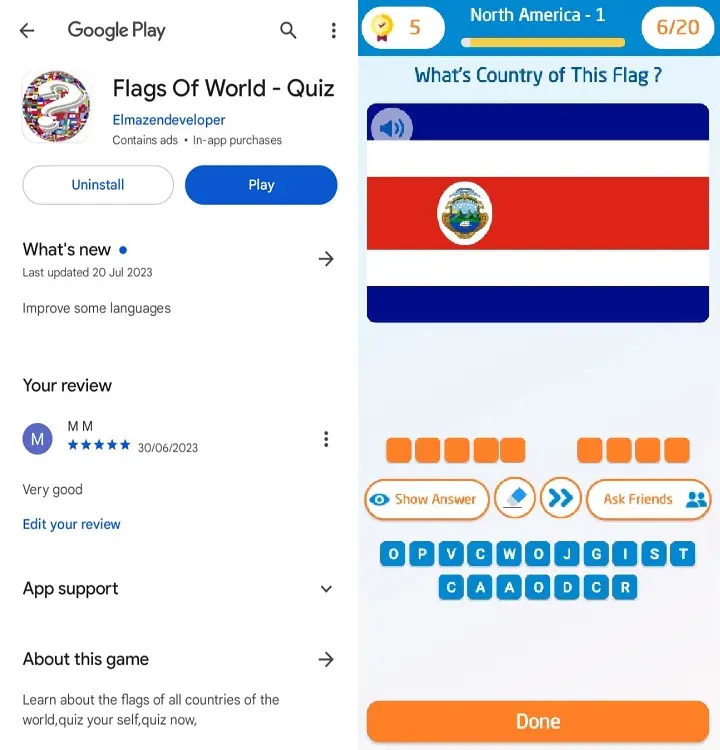
Download the application  Flags Of World - Quiz ,
Flags Of World - Quiz ,
And test your knowledge with Flags of World ,
1. Population of Costa Rica :
As of November 2024, Costa Rica’s population is around 5.13 million people.
This number has grown steadily, although Costa Rica has a relatively small population compared to other Latin American countries.
The majority of Costa Ricans (known as "Ticos" for men and "Ticas" for women) live in the Central Valley region, including the capital, San José, as well as Alajuela, Heredia, and Cartago.
2. Meaning of Costa Rica’s Flag :
Costa Rica’s flag consists of five horizontal stripes: a blue stripe at the top, followed by a white stripe, a broad red stripe in the center, another white stripe, and a blue stripe at the bottom.
The colors hold symbolic meaning:
Blue: represents the sky, opportunities, and perseverance.
White: stands for peace, wisdom, and happiness.
Red: symbolizes the blood shed for freedom and the warmth of the Costa Rican people.
On the left side of the red stripe, Costa Rica's flag also features a national coat of arms that includes mountains, ocean views, and seven stars representing Costa Rica’s seven provinces.
A banner reads "República de Costa Rica" (Republic of Costa Rica).
3. Currency of Costa Rica :
The official currency of Costa Rica is the **Costa Rican colón** (plural: colones), often abbreviated as CRC.
Named after Christopher Columbus (Cristóbal Colón in Spanish), this currency reflects Costa Rica’s history.
The colón fluctuates against major currencies like the US dollar, but the US dollar is also widely accepted in tourist areas, especially for larger purchases.
Flag of Costa Rica, Currency, Population

Download the application  Flags Of World - Quiz ,
Flags Of World - Quiz ,
And test your knowledge with Flags of World ,
4. Borders of Costa Rica :
Costa Rica is bordered by **Nicaragua to the north** and **Panama to the southeast**.
Its geographical location places it between the **Caribbean Sea to the east** and the **Pacific Ocean to the west**, giving it access to two coastlines and making it a popular destination for beachgoers and surfers.
This strategic position contributes to its rich diversity of wildlife and ecosystems.
5. Culture of Costa Rica :
Costa Rica’s culture is a blend of indigenous, Spanish, Afro-Caribbean, and immigrant influences.
Here are a few aspects that define the culture:
Pura Vida Lifestyle : The phrase "Pura Vida," which means "Pure Life," reflects the Costa Rican mindset of enjoying life, staying positive, and appreciating nature.
It’s used as a greeting, farewell, or expression of contentment.
Cuisine : Costa Rican cuisine emphasizes fresh ingredients, particularly rice, beans, and corn.
Typical dishes include **Gallo Pinto** (rice and beans usually served with breakfast), **Casado** (a plate of rice, beans, plantains, and protein), and **Ceviche** (marinated fish or seafood).
Fresh fruits like papaya, pineapple, and mango are abundant.
Festivals : Costa Ricans celebrate various festivals, including the **Día de la Independencia** (Independence Day on September 15) and **Semana Santa** (Holy Week before Easter).
These events feature traditional music, dancing, and parades.
Arts and Crafts : Costa Rica is known for its vibrant arts and crafts, especially the traditional **oxcart** (carreta) painted in colorful designs, symbolizing rural life and hard work.
6. Best Places to Visit in Costa Rica :
Costa Rica offers a wealth of natural beauty and attractions.
Here are some of the country’s top destinations:
Arenal Volcano National Park : One of the country’s most active volcanoes until recently, Arenal is surrounded by hot springs, lush rainforests, and stunning waterfalls.
It’s a great place for hiking, zip-lining, and wildlife spotting.
Manuel Antonio National Park : Known for its beautiful beaches and rich biodiversity, this park on the Pacific Coast is home to monkeys, sloths, tropical birds, and more.
It’s ideal for both nature lovers and beachgoers.
Monteverde Cloud Forest Reserve : A unique cloud forest ecosystem, Monteverde is a haven for birdwatchers, as it hosts the resplendent quetzal and hundreds of other bird species.
Canopy tours and hanging bridges allow visitors to explore the forest’s upper layers.
Tortuguero National Park : Located on the Caribbean Coast, Tortuguero is famous for its sea turtle nesting sites.
From July to October, visitors can witness endangered green turtles nesting along the beaches.
Corcovado National Park : Situated on the Osa Peninsula, this park is one of the most biodiverse places on Earth.
Jaguars, tapirs, and scarlet macaws can be found here, making it a favorite among ecotourists and adventure seekers.
Guanacaste : This province on the Pacific Coast is known for its beautiful beaches, such as Playa Tamarindo and Playa Conchal, as well as Rincon de la Vieja National Park, which features geothermal wonders like mud pots and hot springs.
Costa Rica’s dedication to conservation and eco-tourism, combined with its welcoming culture, make it a standout travel destination.
Whether you’re drawn by the natural beauty, the relaxed lifestyle, or the warm hospitality, Costa Rica offers an experience unlike any other.
Flag of Costa Rica, Currency, Population
